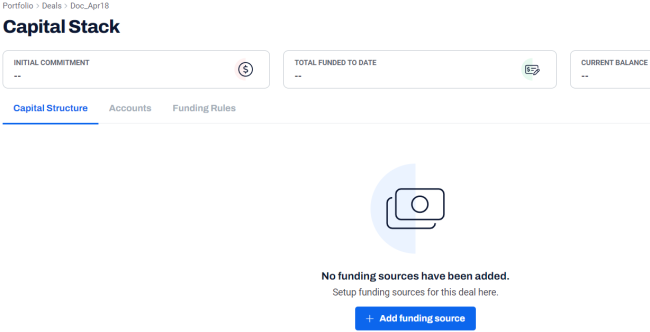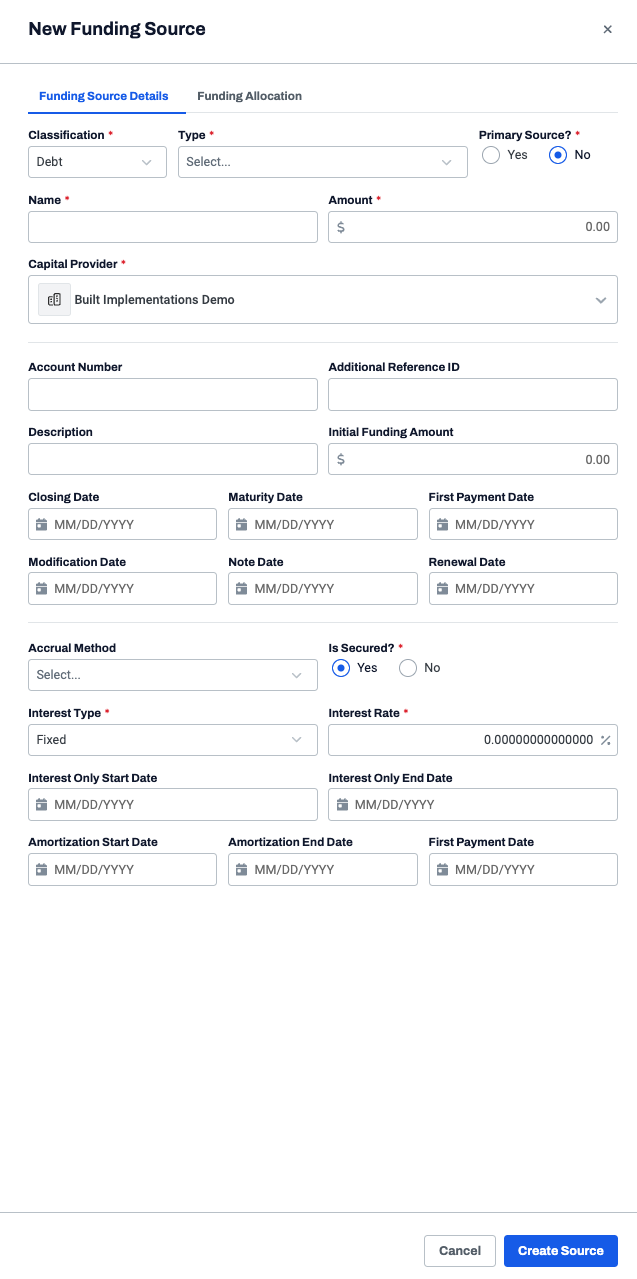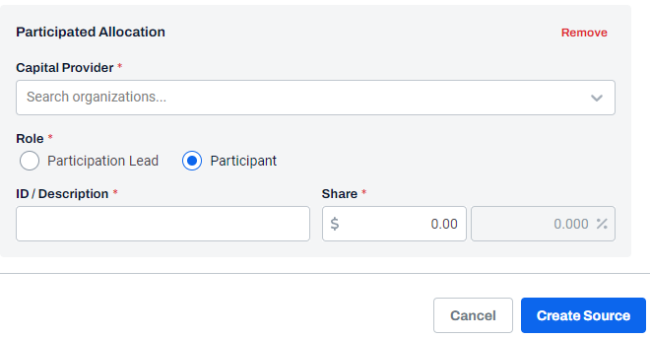Creating a funding source
A funding source is the debt or equity contributing to the capital stack used to fund a deal. There can be a single source or multiple sources of funds. There are various types of funding sources, such as loans, investment capital and tax credits.
Note: Before creating a funding source, ensure that:
• Full access permission is provided to the Deal Management:
• Portfolio Page & Deal Creation
• Deal Details
• Deal Overview
• Capital Stack
• A deal is created
To create a funding source, perform the following steps.
| 1. | At the top-left of the page, click Portfolio. |

| 2. | On the Portfolio page, click Deal ID or click View for the deal for which you want to create a funding source. |

| 3. | On the left navigation menu, click Capital Stack. |

| 4. | On the Capital Stack page, click + Add funding source. |

| 5. | On the New Funding Source page, in the Funding Source Details tab, enter the following information. |

| Field | Description |
|---|---|
| Classification |
Classification types such as Debt, Equity, and Other. This field is mandatory. |
| Type | Funding source types that are added in the Field Configuration. This field is mandatory. |
| Primary Source? | Specifies whether the funding source is the primary source for reporting. This option is mandatory. |
|
Name |
A funding source name. This field is mandatory. |
|
Amount |
A funding amount. This field is mandatory. |
|
Capital Provider |
An entity or individual who supplies financial resources to businesses, projects, or individuals. This field is mandatory and default to the organization name that the user is provisioned to. |
|
Account Number |
A unique identification number within a bank or lender that is used to reconcile interest statements with the loan agreement and is an essential component for tracking and audit purposes. |
|
Additional Reference ID |
An additional reference ID for the funding source loan. |
|
Description |
A funding source description. |
|
Note: The values for the following fields apply to Debt sources only. |
|
|
Initial Funding Amount |
The initial capital funded by the capital provider. |
|
Closing Date |
The date when all terms are settled and a closing agreement is made between the capital provider and borrower. |
|
Maturity Date |
The date when the principal amount of a loan is due to be repaid in full. On this date, any remaining unpaid balance of the loan becomes due and payable to the capital provider. |
|
First Payment Date |
The date when the first installment or payment of a loan agreement is due. |
|
Modification Date |
The date when a change or modification is made to a loan agreement or contract. |
|
Note Date |
The date when a promissory note or loan agreement is issued. |
|
Renewal Date |
The date when a loan or financial agreement is renewed or extended. |
|
Accrual Method |
The method used to record interest income and expenses. |
|
Is Secured? |
Type of loan that is backed by collateral. Specifies whether it is secured. This field is mandatory. |
| Interest Type | The method for determining the interest rate on the loan note. |
| Interest Rate | The percentage of the principal balance that the borrower agree to pay as interest over a specified period, typically annually. This field is available when Interest Type is Fixed. |
| Index | The reference point defined in a loan agreement to determine the interest rate on a loan as configured in Field Configuration. This field is available when Interest Type is Floating. |
| Interest Spread | The additional percentage applied to the index rate to determine the interest rate on a floating rate loan. This field is available when Interest Type is Floating. |
| Interest Rate Floor | The minimum rate of interest to be charged as defined in the loan agreement. This field is available when Interest Type is Floating. |
| Interest Rate Cap | The maximum rate of interest to be charged as defined in the loan agreement. This field is available when Interest Type is Floating. |
| Interest Rate Cap Expiration Date | The expiration date of the maximum rate of interest to be charged. This field is available when Interest Type is Floating. |
| Interest Only Start Date | The date when the interest only period of the loan term starts. |
| Interest Only End Date | The date when the interest only period of the loan term ends. |
| Amortization Start Date | The date when the amortization period of the loan term starts. |
| Amortization End Date | The date when the amortization period of the loan term ends. |
| 6. | Click the Funding Allocation tab. |

| 7. | On the Funding Allocation tab, select the required option such as No Yes, participated or Yes, syndicated. |

| 8. | If Yes is selected, in the Allocation Details section, enter the following information. |

Note:
• The first allocation is default to the users lending organization as the Capital Provider.
• To add additional allocations, click + Add Allocation.
| i | In the Capital Provider drop-down, select the required capital provider. |

|
| ii | In the Role section, select the required option such as Participation Lead or Participant. |
| iii | In the ID/Description field, enter an ID or description. |
| iv | In the Share field, enter an allocation amount. |
Note:
• Repeat the steps above to ensure that the total shares are equal to the total source amount.
• To remove allocation, click Remove.
| 9. | Click Create Source. |
The Capital Stack page is displayed with the newly created funding source.
